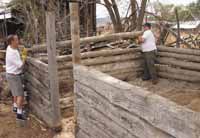| Kenyon Kennard and Cameron Wilson carefully dismantle the old Muddy Creek post office. |
Part of the history of Emery County is moving to a new home. The old post office from the town of Muddy Creek is being taken apart and transported to Salt Lake City to This is the Place Heritage Park. The structure which dates back to 1879 or earlier was used as a post office and home of Casper Christensen who founded Muddy Creek and was its first postmaster. Christensen is listed as the first white settler on the Muddy Creek. His settlement on the right bank of the Muddy is three miles northeast of where the town of Emery now stands. In 1882 the post office was established in Christensen’s home.
The Muddy Creek Post Office which sits on Clyde Mortensen’s land was moved to its present location in Emery in the 1920s to be used as a temporary home and for storage and a granary. Also of note, the President of This Is the Place Heritage Park, Paul Williams, roots come from Emery and Castle Dale, and his great-grandfather likely delivered mail to this cabin.
Working on the moving project is Cameron Wilson, vice president of operations at the park and Kenyon Kennard, curator at the park. “Before the project began, we took pictures and our architect made drawings of the building so it has been fully documented before the moving. Shawn Delliskave whose grandfather was Clyde Mortensen notified the park about the availability of the building and also offered two other buildings on the property. We were most interested in the old post office because it is uncommon for a frontier building used for a public purpose to still be intact. We were also very interested because this is the first building being removed from this area to be used in the park.
“The building will fit in very nicely at the park. These old buildings were not meant to last and many of them didn’t survive very long, so this is a very rare find for us,” said Kennard.
Wilson said, “We are making an effort at the park to expand our programming to include the rest of Utah. We are trying to diversify and include the histories and cultures of the Greek, Jewish, Italian, Chinese, Japanese, German, Irish and others. Many groups had an impact on the early settlement of Utah, not just the Mormon pioneers. We want to tell everyone’s story and have a geographic representation of the whole state.
“The reconstruction of the post office will begin next spring and summer. We hope to have visitors see and participate in the reconstruction. Those doing the reconstruction will be in period costume and it will be rebuilt to duplicate how it now stands,” said Wilson.
“It will take considerable work, because these logs are not in the best of condition. The spots with rot will be treated with chemicals to stop the dry rot. The reconstruction will be accurately done. Each of the logs have been numbered and will go back in their exact locations. The chinking materials will be duplicated in the reconstruction,” said Kennard.
“The This is the Place Heritage Park is a 450 acre facility that has been a park for the last 30 years. It is on the east side, just across from the Hogle Zoo. The park contains 40 historic buildings. A new headquarters building has just been completed to replicate the Smoot Hall at the old BYU academy and our offices are housed in there. The park is also the location for the This is the Place monument.
“The park is presently ready for expansion. In a joint effort with the Hogle Zoo we will be putting in historical exhibits showcasing native animals in as close to their natural environment as possible. It is a big opportunity and a big project for future years. The park is a wonderful place to come and celebrate history as a premier living history park. The park is owned by the state and operated by a non-profit foundation called This is the Place Foundation. We have over 300,000 visitors per year,” said Wilson.
“We are also very active with school programs and teaching Utah history. We have many school children visit the park on field trips. We also have many tourists and tour buses that stop every day,” said Kennard.
Wilson said, “We are especially proud of our festivals. We have a pumpkin patch, haunted desert and sleepy hollow. At Christmas we have Candlelight Christmas. During the summer we have Liberty Days. We have full production musicals and plays and all kinds of activities. We have many activities and interactive learning experiences for the visitors in about three quarters of the buildings. The people participating are in costume.
“We specialize in edutainment. This is a word we’ve coined to express what we do here at the park. We educate, but also entertain. Our educational program is also expanding. We will teach trades here at the park. You will be able to come to the park to learn blacksmithing and other pioneer trades and skills. We’ll teach you how to raise quality crops and vegetables.
“We have a great mission here at the park to show children our heritage so they will never forget our pioneers and as we look to the future as our own pioneers. Each generation has its own unique pioneers and everyone is a pioneer in their own way,” said Wilson.
The old Christensen post office will be in good company at the park. It will join cabins and buildings from the Brigham Young family, Huntsmans and the Kimballs to name a few.
Wilson and Kennard welcome the county to come and view this piece of Emery County history at its new home next year at the park.

